|
The Struggling Mouse, introduced in 1919, was designed to mimic the action of a small rodent. This example includes a color flyer bragging about its effectiveness as a bass catcher. This particular boxed specimen emerged a few years back in Pennsylvania. |
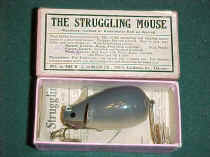 |
|
The Nemo, patented in 1910, was short-lived in production but remains one of the all-time classics among collectible lures. Just as the Captain Nemo of novel fame could travel beneath the sea, so could this revolving head lure, by virtue of a round, removable belly weight that compelled this intriguing bait to travel beneath the surface. Remove the weight, and you have a topwater lure. This box includes a picture flyer advertising the Nemo as "new" and mentions their availability in Musky Size as well! |
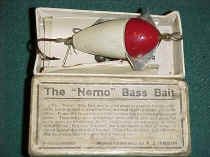 |
|
Jamison's Mascot lures were first offered in 1916. The most elusive is the "Weedless Mascot" shown here, which has a bulbous head, no diving fins or planes at all, and two line ties that permitted the bait to be fished with varying degrees of action. The alignment of the double hooks provided the so-called weedless function. The paperwork with this example is printed on heavy stock orange-yellow cardboard, and is one of the company's earlier flyers for the Mascot lures. |
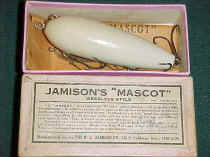 |
|
The Humdinger lure is similar to the Mascot, but with the diving planes mounted on the opposite end of the body. This bait, also introduced in 1916, bears similarities to the Struggling Mouse as well. The paperwork includes a pink printed flyer advertising Bill Jamison's quality brands of casting lines. |
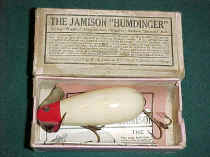 |
|
The Chicago Wobbler is one of the hardest Jamison lures to find. Unlike the Weedless Mascot, this topwater jerk bait has only one line tie. Offered in many colors, including solid red, rainbow and all yellow, these rare baits tend to turn up most often in red and white. The box is one of the toughest to find. This example, which came from an auction in Massachusetts, is the only one I've seen in 22 years of collecting. |
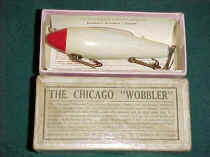 |
|
The No. 1 Winged Mascot is a fascinating lure with adjustable metal wings on its head. The double hooks in the belly folded against the body to make it weedless. This early classic dates to the 1915-1916 era and is new in the box with two different sets of paperwork. Jamison printed instructions for fishing his baits on the cover of almost every box. |
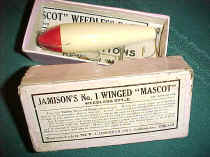 |
The No. 2 Winged Mascot is similar to the lure shown above, but is smaller and shorter. The metal wings in the head could be detached by removing the screw and reversed - making it "two baits in one," according to the abundant and verbose product literature. Note the stamp in ink denoting "red and white bait," Jamison's most common paint finish. |
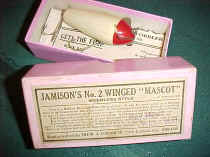 |
This is the Muskie Winged Mascot - and although it has no box, it it a terribly tough lure to find. Notice the black Japanned hooks and the huge broomstick-width body. This interesting bait was found in a tackle box acquired from a visitor to this website. I would like to find more of these baits, and especially need a boxed example of this early antique lure. |
 |
This is a very rare Deluxe No. 2 Winged Mascot, mint in its original box with instructions. The Jamison "Deluxe" finish offered anglers the option, for a higher price, of special ordering Jamison lures with glass eyes and a wonderful scale paint finish. Needless to say, not many have turned up. Note the "Deluxe" stamp in ink on this beautiful circa 1915 box. |
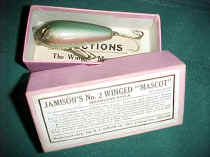 |
Bill's Bass Getter, named for Bill Jamison, of course, offered the added feature of Jamison's patented "humane" barbless hooks. This lure was made around 1917 - and was available only a year. This is the only example of this box that I'm aware of. Like most of Jamison's lures, this bait is finished in read and white and has no eye detail at all. |
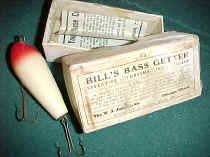 |
|
The Hastings Weedless Frog is one of the lures Bill Jamison sold, but did not invent. The lure was first patented in 1895 and sold by the James T. Hastings & Company of Chicago, although may people mistakenly associate the Hastings Frog with Hastings, Michigan. Bill Jamison acquired the rights to the lure sometime before 1910. Here are two later examples of the lure in two different boxes. |
 |
Here is an earlier, rare box that includes the same picture that appears on the 1895 James Hastings Frog box, but has the added verbage that it is a Jamison product. The box carton is the standard size and otherwise quite similar to the later Hastings Weedless Rubber Frog boxes shown above. This box is much harder to find than the picture-less versions. |
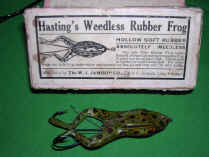 |
|
Here is a very rare transition box that bridges the gap between the 1895 Hastings Frog picture box sold by James Hastings and the early Jamison picture box shown above. This rare box, the only example I've ever seen, is also a "long" box and quite possibly was made by Hastings and overlabeled by Jamison A notation at the bottom describes Jamison as the "successor to Jas. T. Hastings & Co." You won't see this box anywhere else. |
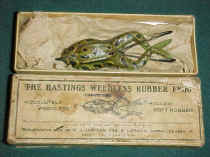 |
|
Jamison's brief foray into the flyrod lure industry included the elegant little Flyrod Wiggler, a miniature, Mascot-like wooden lure sold around 1917. This is the more common small size in the tiny 2-inch box. The rainbow color is elegant, and the lure also has tiny hand-painted gill marks. |
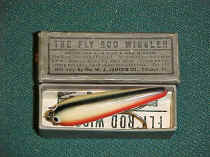 |
|
The large size Flyrod Wiggler is much rarer than the tiny one pictured above. Although similarly marked, the gray box is almost twice the size as the example above, and infinitely harder to find, especially in decent shape. This bait is in Silver Shiner finish, according to the box, and also has hand-painted gill marks on the chin. |
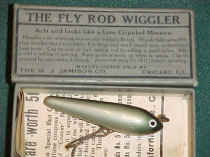 |